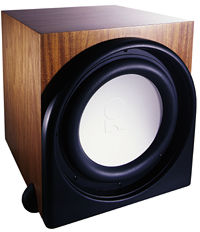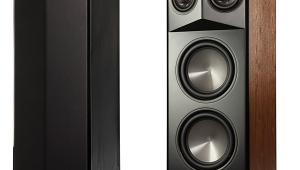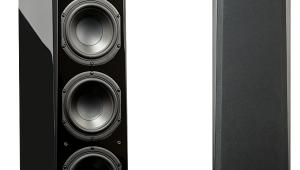Revel Performa F30 surround speaker system Page 4
 As for the center channel, the Ultima Voice sounded smoother than the Performa C30; JT's voice on the James Taylor Live at the Beacon Theater DVD had a very slight metallic quality with the C30, but not with the Voice. And the design of the Voice suggests a greater dynamic capability for a large room; it certainly provided all the output I ever needed in the 7000-cubic-foot home-theater space I had in Santa Fe. But neither the Voice nor the C30 was stressed to its dynamic limits in my current, more average-sized home theater.
As for the center channel, the Ultima Voice sounded smoother than the Performa C30; JT's voice on the James Taylor Live at the Beacon Theater DVD had a very slight metallic quality with the C30, but not with the Voice. And the design of the Voice suggests a greater dynamic capability for a large room; it certainly provided all the output I ever needed in the 7000-cubic-foot home-theater space I had in Santa Fe. But neither the Voice nor the C30 was stressed to its dynamic limits in my current, more average-sized home theater.
If you do decide on a Revel Ultima setup, don't ignore the mix'n'match possibilities. The S30s should perform surround duties nearly as well as the Ultima Embraces, and might provide an otherwise financially impractical route to four surrounds (sides and rears) rather than two. And I'd choose the B15 subwoofer over the Ultima Sub15/LE-1. A single Sub15 costs $9400 with the outboard Ultima amplifier. If the B15's output is insufficient (hard to believe), you can buy three of them for the price of a single Ultima LE-1 and amp, with change left over.
Music
The tendency of the Performas to sound slightly crisp on top and lean in the midbass rather than warm and sweet was also evident with music, most of which I listened to in straight 2-channel+subwoofer mode. But as with soundtracks, the top-end detail and resolution remained superb, the midrange free of any obvious colorations, and the bass tight and clean.
The imaging and depth were solid and convincing, if a bit compromised by the presence of a fixed screen and the off-center listening position demanded by a projector located squarely in the imaging sweet spot. To get around at least the latter problem, I tried the F30s as a 2-channel pair in a smaller room (about 13x17x8.5 feet), both with and without a subwoofer—in this case, the modest but impressive Hsu VTF-2. (It wasn't practical to relocate the Revel sub for this portion of the listening tests.) A screen—a plasma, in this case—intervened here, too, but at least I could rest my gluteus maximi in a chair properly positioned for stereo: midway between the left and right speakers. Here the imaging, if not the most pinpoint I've ever heard, was nevertheless stable and believable, and the depth, while not head-turning, was effective. The limitations were minor, and likely due to that plasma screen and the F30's front baffle, which is slightly wider than typical.
In other ways as well, the F30s produced surprisingly good sound in this setup, driven by—hold your breath—the Outlaw 1050 A/V receiver. Yes, a $500 receiver. The source was the digital output of a Denon DVD-2800 DVD player, and speaker cables were an ancient THX-certified set from Monster. This isn't to say that the Outlaw was an ideal partner for the Revels, only that you might be astonished to hear how well they worked together, with or without a subwoofer. When driven full-range, the F30s' bass extended as deep as the Hsu's, even with the latter in a corner. But the Hsu's bass was tighter, probably because the Outlaw really didn't have the power to get the most out of the F30s' bottom end.
Nevertheless, the synergy of the F30s and the Hsu in this room reminded me of one of the best arguments for using a subwoofer: the location producing the best bass in a room is rarely the location that provides the best imaging. But while I always recommend a subwoofer in a home theater for that reason and others, it was obvious from my listening tests that there aren't many full-range speakers that can do a better job in the bass than the F30.
Conclusion
When we visited Revel at their Northridge, California home a year or so back (see “Revelations," July/August 2000), we were impressed by the state-of-the-art facilities available to their engineers for designing, testing, auditioning, and building loudspeakers. Yet even such sophisticated and important tools are less important than the people who employ them. From the evidence here, those tools are being put to good use. These Revels are not inexpensive, but you can spend a lot more than this and not get anywhere near this quality in home theater sound. The Performas are exceptional—and highly recommended.





























































